EX_Mailbox_SDD Job
The EX_Mailbox_SDD job locates sensitive data found in mailboxes in the Exchange environment.
Special Dependency
-
Sensitive Data Discovery Add-On installed on the Enterprise Auditor Console server
- See the Sensitive Data Discovery Add-On Installation topic for additional information
NOTE: Though the job is visible within the console, it requires an additional installer package before data collection occurs.
Queries for the EX_Mailbox_SDD Job
The EX_Mailbox_SDD job uses the EWSMailbox Data Collector.

The following query is included in the EX_Mailbox_SDD job:
-
Exchange Sensitive Data Discovery – Collects potentially-sensitive data from mailboxes
-
Set to search all mailboxes. It can be scoped.
-
Default sensitive data criteria includes:
- Birth Records
- Credit Cards
- Passwords
- Tax Forms
- US SSN
-
-
See the Configure the EWSMailbox Data Collector for the EX_Mailbox_SDD Job topic for additional information
Configure the EWSMailbox Data Collector for the EX_Mailbox_SDD Job
The Exchange Sensitive Data Discovery query has been preconfigured to run with the EWSMailbox Data Collector to scan for sensitive data.
Follow the steps to configure the scope of the EWSMailbox Data Collector:
Step 1 – Navigate to the Exchange > 7. Sensitive Data > 0. Collection > EX_Mailbox_SDD > Configure node and select Queries.
Step 2 – In the Query Selection view, select the Exchange Sensitive Data Discovery query and clickQuery Properties. The Query Properties window opens.
Step 3 – Select the Data Source tab, and click Configure. The EWS Mailbox Data Collector Wizard opens.
CAUTION: Do not make changes to other wizard pages as they have been pre-configured for the purpose of this job.
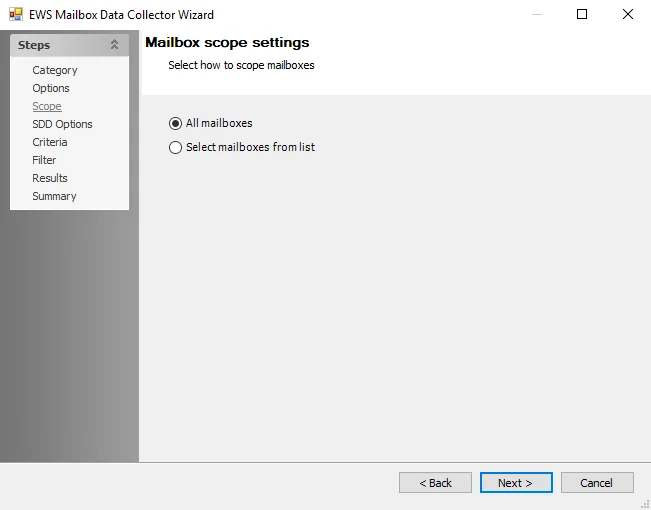
Step 4 – To scope the query for specific mailboxes, navigate to the Scope page. The query is configured by default to target All mailboxes. Change the Mailboxes to be queried to **Select mailboxes from list.**See the EWSMailbox: Scope topic for additional information.
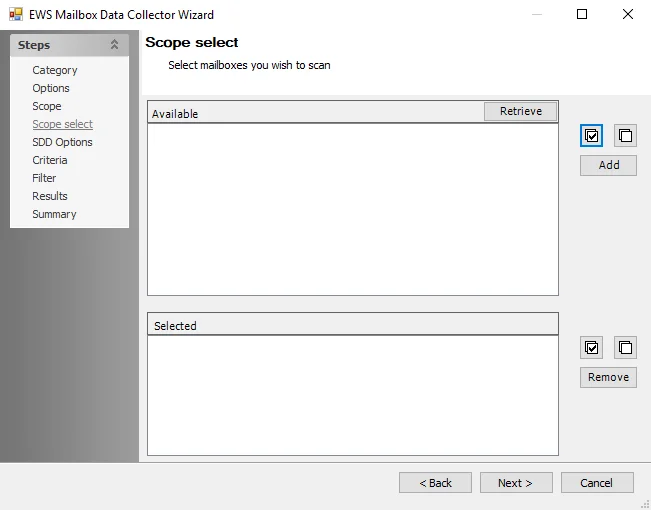
Step 5 – To retrieve available mailboxes, click Retrieve on the Scope Select page. Select the desired mailboxes and click Add. See the EWSMailbox: Scope Select topic for additional information.
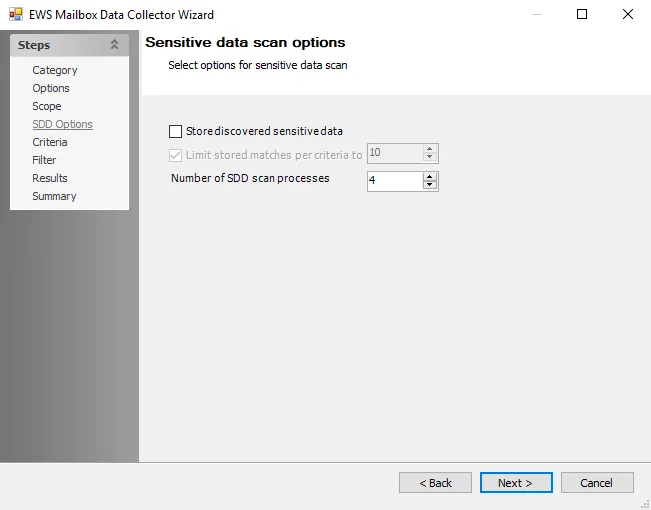
Step 6 – To enable storage of discovered sensitive data, navigate to the SDD Options page. Sensitive data matches can be limited to reduce storage space. See the EWSMailbox: SDD Options topic for additional information.
NOTE: By default, discovered sensitive data strings are not stored in the Enterprise Auditor database.
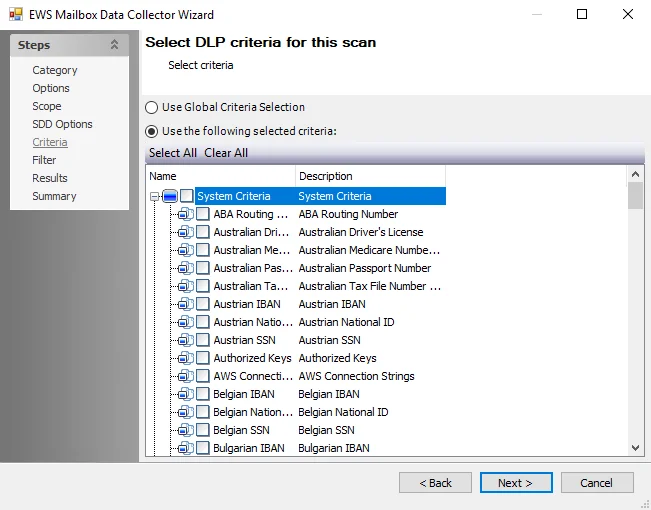
Step 7 – To modify criteria, navigate to the Criteria page. Add or remove criteria as desired. See the EWSMailbox: Criteria topic for additional information.
- (Optional) To create custom criteria, see the Sensitive Data Criteria Editor topic for additional information
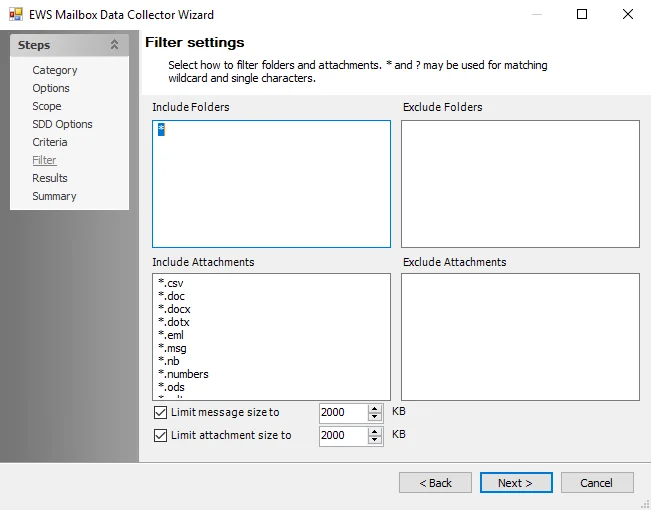
Step 8 – To filter the scan to specific mailbox folders, navigate to the Filter page. Include or exclude folders and attachments as desired. See the EWSMailbox Data Collector topic for additional information.
- To modify the threshold for message size, set the Limit message size to value as desired. The default is 2000 KB.
- To modify the threshold for large attachment size, set the Limit attachment size to value as desired. The default is 2000 KB.
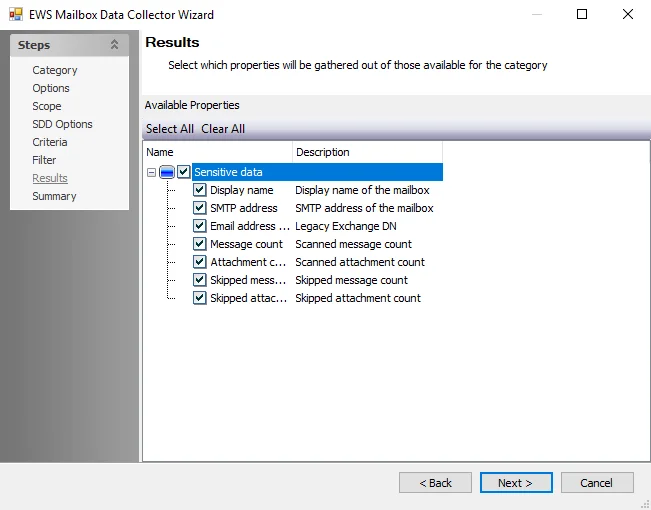
Step 9 – Navigate to the Results page to select which properties are gathered based on category. See the EWSMailbox: Results topic for additional information.
NOTE: By default, all categories are selected under sensitive data.
Step 10 – Navigate to the Summary page, click Finish to save any setting modifications or click Cancel if no changes were made. Then click OK to close the Query Properties window
The job now applies the modification to future job executions.
Analysis Tasks for the EX_Mailbox_SDD Job
View the analysis task by navigating to the Exchange > 7.Sensitive Data > EX_Mailbox_SDD > Configure node and select Analysis.
CAUTION: Do not modify or deselect the selected analysis task. The analysis task is preconfigured for this job.

The following analysis task is selected by default:
- AIC Import - Exchange SSD – Imports Exchange sensitive data to the Access Information Center
EX_PublicFolder_SDD Job
The EX_PublicFolder_SDD job locates sensitive data found in public folders in the Exchange environment.
Special Dependency
-
Sensitive Data Discovery Add-On installed on the Enterprise Auditor Console server
- See the Sensitive Data Discovery Add-On Installation topic for additional information
NOTE: Though the job is visible within the console, it requires an additional installer package before data collection occurs.
Queries for the EX_PublicFolder_SDD Job
The EX_PublicFolder_SDD job uses the EWSPublicFolder Data Collector.

The following query is included in the EX_PublicFolder_SDD job:
-
Exchange Sensitive Data Discovery – Scans Exchange public folders for specified sensitive data
-
Set to search all public folders. It can be scoped.
-
Default sensitive data criteria includes:
- Birth Records
- Credit Cards
- Passwords
- Tax Forms
- US SSN
-
See the Configure the EX_PublicFolder_SDD Query topic for additional information
-
Configure the EX_PublicFolder_SDD Query
The Exchange Sensitive Data Discovery query has been preconfigured to run with the EWSPublicFolder Data Collector to scan for sensitive data.
Step 1 – Navigate to the Exchange > 7. Sensitive Data > 0. Collection > EX_EWSPublicFolder_SDD > Configure node and select Queries.
Step 2 – In the Query Selection view, select Exchange Sensitive Data Discovery and click Query Properties. The Query Properties window opens.
Step 3 – Select the Data Source tab, and click Configure. The EWS Public Folder Data Collector Wizard opens.
CAUTION: Do not modify other wizard pages. The wizard pages are pre-configured for this job.

Step 4 – To enable storage of discovered sensitive data, navigate to the SDD Options page. Sensitive data matches can be limited to reduce storage space. See the EWSPublicFolder: SDD Options topic for additional information.
NOTE: By default, discovered sensitive data strings are not stored in the Enterprise Auditor database.

Step 5 – To modify criteria, navigate to the Criteria page. Add or remove criteria as desired. See the EWSPublicFolder: Critieria topic for additional information.
- (Optional) To create custom criteria, see the Sensitive Data Criteria Editor topic for additional information
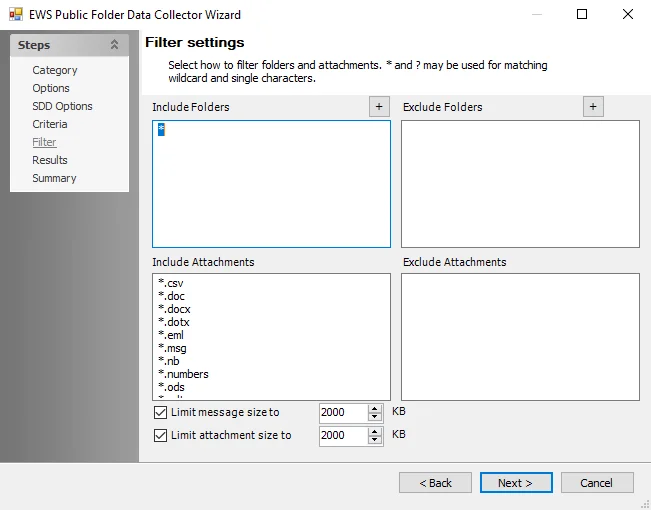
Step 6 – To filter the scan to specific mailbox folders, navigate to the Filter page. Include or exclude folders and attachments as desired. See the EWSPublicFolder: Filter topic for additional information.
- To modify the threshold for message size, set the Limit message size to value as desired. The default is 2000 KB.
- To modify the threshold for large attachment size, set the Limit attachment size to value as desired. The default is 2000 KB.
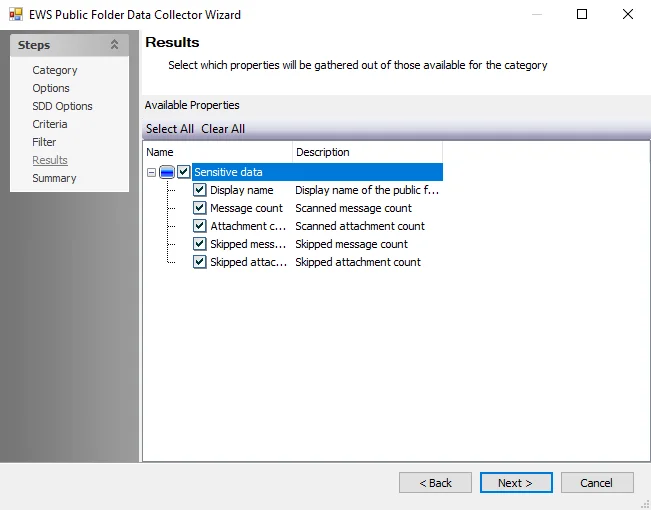
Step 7 – To select which properties are gathered based on category, navigate to the Results page. See the EWSPublicFolder: Results topic for additional information.
NOTE: By default, all categories are selected under sensitive data.
Step 8 – Navigate to the Summary page, click Finish to save any setting modifications or click Cancel if no changes were made. Then click OK to close the Query Properties window
The job applies the modification to future job executions.
0.Collection Job Group
The 0.Collection job group locates sensitive data found in mailboxes and public folders in the Exchange environment.
The jobs in the 0.Collection job group are:
- EX_Mailbox_SDD Job – Collects potentially sensitive data in mailboxes
- EX_PublicFolder_SDD Job – Collects potentially sensitive data in public folders
EX_SDDResults Job
The EX_SDDResults job contains analyses and reports to provide insight into the types of sensitive data that is located within Exchange mailboxes and public folders within the environment.
Analysis Tasks for the EX_SDDResults Job
View the analysis tasks by navigating to the Exchange > 7. Sensitive Data > EX_SDDResults > Configure node and select Analysis.
CAUTION: Do not modify or deselect the selected analysis tasks. The analysis tasks are preconfigured for this job.
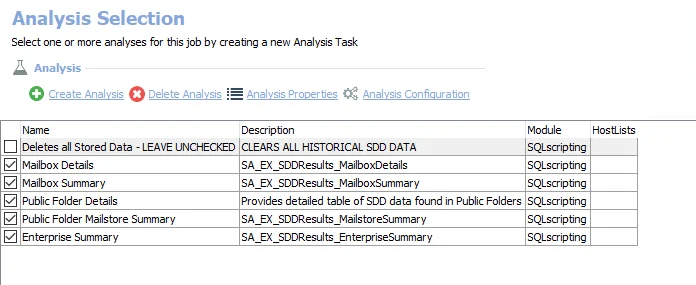
The following analysis tasks are selected by default:
- Mailbox Details – Creates the EX_SDDResults_MailboxDetails table, accessible under the job’s Results node. Provides details regarding the number of matches that are found per item in each mailbox.
- Mailbox Summary – Creates the EX_SDDResults_MailboxSummary table, accessible under the job’s Results node. Summarizes the items found with matches.
- Public Folder Details – Creates the EX_SDDResults_PublicFolderDetails table, accessible under the job’s Result node. Provides details regarding the number of matches that are found per item in each public folder.
- Public Folder Mailstore Summary – Creates the EX_SDDResults_PublicFolderSummary table, accessible under the job’s Results node. Summarizes the items found with matches.
- Enterprise Summary – Creates the EX_SDDResults_EnterpriseSummary table, accessible under the job’s Results node. Summarizes the type and amount of sensitive content found in the environment.
The following analysis task deletes table data from data collection and analysis jobs. This analysis task should remain cleared unless specifically needed:
CAUTION: Do not select the Deletes all Stored Data option. This analysis task is for troubleshooting and cleanup only. Data will be deleted from the database.
-
Deletes all Stored Data - LEAVE UNCHECKED – Clears all historical SDD data
- See the Troubleshooting Data Collection topic for additional information
In addition to the tables and views created by the analysis tasks, the EX_SDDResults Job produces the following pre-configured reports.
| Report | Description | Default Tags | Report Elements |
|---|---|---|---|
| Enterprise Summary (Sensitive Content) | This report identifies the type and amount of sensitive content found in scanned mailboxes. | None | This report is comprised of two elements: - Bar Chart – Displays exceptions by item count - Table – Provides a criteria summary |
| Mailbox Details (Mailboxes with Sensitive Content) | This report identifies the mailboxes containing sensitive data. | None | This report is comprised of three elements: - Bar Chart – Displays top mailboxes by sensitive item count - Table – Provides mailbox details - Table – Provides details on top mailboxes by sensitive item count |
| Public Folder Details (Public Folders with Sensitive Content) | This report identifies the public folders containing sensitive data. | None | This report is comprised of three elements: - Bar Chart – Displays top folders by sensitive data item count - Table – Provides public folder details - Table – Provides details on top folders by sensitive item count |
7.Sensitive Data Job Group
The 7. Sensitive Data job group is comprised of jobs which locate sensitive data found in mailboxes and public folders in the Exchange environment.
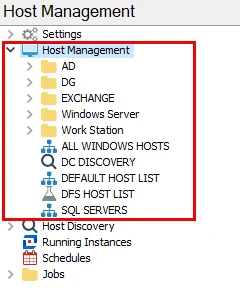
The following comprise the 7. Sensitive Data job group:
NOTE: These jobs are compatible with the Office 365 environment.
- 0.Collection Job Group – Locates sensitive data found in mailboxes and public folders in the Exchange environment
- EX_SDDResults Job – Contains analyses and reports to provide insight into the types of sensitive data that was located within Exchange mailboxes and public folders within the environment
The 7. Sensitive Data job group is comprised of jobs that utilize the EWSMailbox and EWSPublicFolder Data Collectors to locate sensitive data found in mailboxes and public folders in the Exchange environment. It also contains analysis and reporting jobs to order and analyze the data returned by the queries. See the Exchange topic for additional information.
Recommended Configurations for the 7. Sensitive Data Job Group
Dependencies
This job group requires the following item to be installed and configured on the Enterprise Auditor Console:
- Enterprise Auditor Sensitive Data Add-On installed
The following job groups need to be successfully run:
- .Active Directory Inventory Job Group
Targeted Hosts
The 0.Collection Job Group needs to be set to run against:
- Local host
The 0.Collection > EX_Mailbox_SDD and 0.Collection > EX_PublicFolder_SDD jobs need to be set to run against the version-appropriate default dynamic host list:
- Exchange 2010 MB Servers
- Exchange 2013 MB Servers
- Exchange 2016 MB Servers
- Exchange 2019 MB Servers
NOTE: Default dynamic host lists are populated from hosts in the Host Master Table which meet the host inventory criteria for the list. Ensure the appropriate host lists have been populated through host inventory results.
Connection Profile
A Connection Profile must be set directly on jobs within the 0.Collection job group. See the Exchange Web Services API Permissions topic for the EX_PFInfo job requirements.
See the Connection topic for additional information.
Schedule Frequency
This job group has been designed to run as desired.
Query Configuration
The 7. Sensitive Data Job Group is designed to be run with the default query configurations. However, the following queries can be modified:
- 0.Collection > EX_Mailbox_SDD Job – Exchange Sensitive Data Discovery Query
- 0.Collection > EX_PublicFolder_SDD Job – Exchange Sensitive Data Discovery Query
No other queries should be modified.
Workflow
Step 1 – Set the host on the EX_Mailbox_SDD or EX_PublicFolder_SDD job.
Step 2 – Set a Connection Profile on the jobs which run data collection.
Step 3 – Schedule the 7. Sensitive Data job group to run as desired.